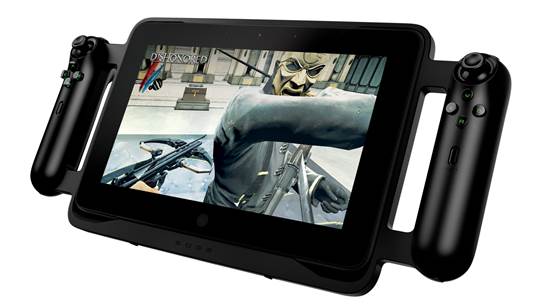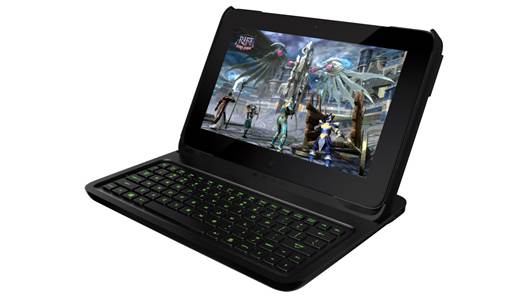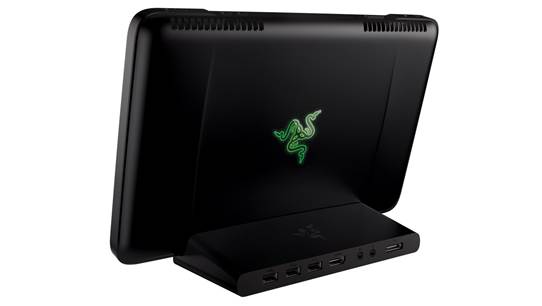Tablet with an identity crisis?
When you hear the phrase “tablet gaming,
what comes to mind? Angry Birds, Infinity Blade and The Walking Dead games?
Well what if we told you that Call of Duty: Black Ops 2, Batman: Arkham City
and Far Cry 3 were now tablet territory? That’s the dream being dreamt by the
gaming aficionados at Razer. The makers of high-end gaming laptops like the
Razer Blade and slick peripherals like the Razer Sabertooth controller now
present the Razer Edge. This Windows 8 tablet for the hardcore set comes in two
flavors: Razer Edge and Razer Edge Pro.
We reviewed the Pro, which has an i7 Intel
processor, 8GB of RAM, a 2GB Nvidia GT 640M LE and the option of a 128GB or
256GB solid state drive. Essentially, it’s a W8 slate with the guts to game,
but it’s made player-friendly through excessive accessorization. Sold
separately there’s a Docking Station for easy charging and port access, and the
Gamepad controller, a one-of-a-kind rig that gives you console style control
sticks, bumpers and triggers.

Razer
Edge
The Pro review unit with the 256GB SSD
retails for $1,450, while the lower-end version is $1,000. Tacking on a Gamepad
is an additional $249, and the dock is $99, so you could be spending $1,700 or
$1,800. For that kind of money, you could buy a laptop with far more power and
functionality than this accessorized tablet. A laptop would be more portable
too, since it has no extra gear to haul.
These are the exact same reasons that we
couldn’t love the Lenovo ThinkPad Tablet 2 and the Acer Iconia W510 as much as
we wanted to. Still, while it lacks portability and affordability, the Razer
Edge does have two big things going for it: power and novelty. When docked in
the Gamepad controller, the Edge is fun to hold, and everyone who saw us
playing gawked and wanted a turn.
Getting your hands dirty
At a little over 2 pounds and 0.8-inches
thick, you can tell that it’s packing a little more heat than your average W8
slate. The question is though, just how well does it pull it off? Pretty well,
we’d say.
We tested the Edge using a handful of tough
titles, and it managed more than playable frame rates in all of them. Call of
Duty: Black Ops 2, Far Cry 3, Dirt 3 and The Witcher 2 all played admirably at
the Edge’s native resolution of 1,366 x 768. We also kept the graphic details
at medium. Putting them higher than that, or layering on the anti-aliasing,
dragged the frame rate down. One of the most impressive things about the Razer
Edge Pro was the way it could go between a resource hogging title like Far Cry
3 and the Windows 8 Start Screen. With just a press of the Windows button it
toggles between the two with nary a stutter.
Staying in control
In our opinion, there’s not much point in
owning the Razer Edge unless you spring for the gamepad controller. It’s an
extra $249, so coupled with a Razer Edge Pro at $1,450, you’re looking at a
$1,700 investment. That stings, a lot, but with the gamepad controller you get
a very unique gaming experience, and everything you need to actually boot up
and play a game that’s not optimized for touch.
Just like the Razer Edge tablet, the
gamepad controller exudes quality construction and feels very nice to hold. It
also has its own battery, which gives a much needed boost to the Edge’s overall
battery life.

The
first time you play a game, you’ll want a keyboard. After that, the Gamepad and
Big Picture make a great team
When the Edge sits in this rig, it feels
like you’ve crossbreed an Xbox 360 controller with a Wii U GamePad. If you’re
using the Gamepad controller, going into Steam’s Big Picture Mode is a match
made in heaven. Big Picture and the Gamepad created the most seamless
experience we had on the Razer Edge, but there were hiccups.
Having to copy-paste CD keys to activate
games was annoying, and when we played Far Cry 3 and Batman: Arkham City,
third-party services like Games for Windows Live reared their ugly heads, and
were far less optimized for a controller. The first time you play a game,
you’ll want a keyboard. After that, the Gamepad and Big Picture make a great
team.

We
completely support the Razer Edge’s idea of putting gaming first in the tablet
experience. The poor battery makes it significantly less portable and we wonder
whether embracing Android would make more sense
Power hungry
Battery life is one place where the Razer
Edge’s portability really comes into question. In a battery drain test looping
an HD video with full brightness and Wi-Fi connected, the tablet lasted 4 and
half hours. Not bad, but this puppy is designed to do a lot more than watching
movies. Playing Far Cry 3 using both the tablet and the Gamepad’s battery, we
got just a little over two hours of gaming. That’s not terrible, considering
the horsepower at work, but don’t expect to game through a long flight.
We completely support the Razer Edge’s idea
of putting gaming first in the tablet experience. The poor battery makes it
significantly less portable and we wonder whether embracing Android would make
more sense.
Razer Edge specifications
General
·
Packaged Quantity: 1
·
System Type: Slate Tablet PC
·
Mechanical Design: No keyboard
·
OS: Provided Microsoft Windows 8
·
Notebook type: HD display, Gaming
Processor / Chipset
·
CPU: Intel 3rd Gen Core i7, 3 i7-3517U / 1.9
GHz
·
Max Turbo Speed: 3 GHz
·
Number of Cores: Dual-Core
·
Cache: 4 MB
·
Features: Hyper-Threading Technology
Memory
·
RAM: 8 GB, ( 2 x 4 GB )
·
Technology: DDR3 SDRAM
·
Speed: 1600 MHz / PC3-12800
Storage
·
Hard Drive: 256 GB SSD
·
Interface Serial: ATA-600
Display
·
Type: 10.1 in Yes - IPS
·
Max Resolution: 1366 x 768 ( HD )
·
Widescreen: Yes
·
Features: 10-point multi-touch
Audio & Video
·
Graphics Processor: NVIDIA GeForce GT 640M LE
/ Intel HD Graphics 4000 - 2 GB DDR3 SDRAM
·
Memory Allocation: Technology Dynamic Video
Memory Technology 5.0
·
Video System Features: NVIDIA Optimus
·
Camera: Yes
·
Resolution: 2 Megapixel
·
Sound: Stereo speakers , Stereo microphone
·
Compliant Standards: Dolby Home Theater v4
Input
·
Type: Touch-screen
·
Communications: Wireless 802.11n, Bluetooth
4.0
Battery
·
Technology: Lithium polymer
·
Capacity: 5600 mAh
Connections & Expansion
·
Interfaces: USB 3.0, Headphone/microphone
combo jack, Dock
Dimensions & Weight
·
Width 11 in
·
Depth 0.8 in
·
Height 7 in
·
Weight 33.9 oz
|